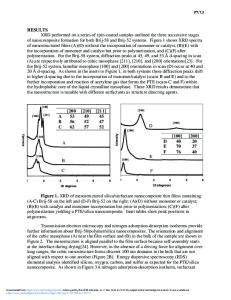Improved Electrochemical Durability of PtRuAu/C Catalyst Synthesized by Radiolytic Process
- PDF / 797,388 Bytes
- 6 Pages / 595.28 x 841.89 pts (A4) Page_size
- 0 Downloads / 254 Views
Improved Electrochemical Durability of PtRuAu/C Catalyst Synthesized by Radiolytic Process Satoru Kageyama1, Akio Murakami1, Satoshi Seino1, Takashi Nakagawa1, Hideo Daimon2, Takao A. Yamamoto1 1 Grad. Sch. Eng., Osaka University, Yamadaoka 2-1, Suita, Osaka, 565-0871, Japan. 2 Hitachi Maxell, Ltd., 1-1-88 Ushitora, Ibaraki, Osaka, 567-8567, Japan.
ABSTRACT Nanoparticle catalyst of PtRuAu/C for direct methanol fuel cell anodes was synthesized by a radiolytic process. Its methanol oxidation activity and the electrochemical durability were evaluated by using the linear sweep voltammetry and the cyclic voltammety. The Au addition significantly improved the durability in comparison with PtRu/C catalyst without losing its high activity. The atomic structure was characterized with techniques of the transmission electron microscopy, the X-ray diffraction, the X-ray fluorescence spectroscopy and the X-ray absorption fine structure. These results implied that the arrangement of Pt and Ru atoms in the PtRuAu/ C has no significant difference from that without Au, possessing a structure of Pt rich core and PtRu alloy shell. We concluded that the improvement in durability could originate from these PtRu nanoparticles decorated with Au, but not from particles with high Au contents.
INTRODUCTION Direct Methanol Fuel Cell (DMFC) is one of the most promising power sources for mobile devices in near future. The main advantages of this fuel cell are ease of replenishment with a new cartridge and a high volumetric energy density, about 10 times larger than that of the lithium ion batteries. However, the high cost of Pt contained in the catalysts is the critical barrier to the commercial use. Therefore, it is necessary to improve the catalytic activity, the durability and the productivity of synthesis process. Although the activity has been improved by alloying Ru with Pt [1], the durability and the productivity of synthesis process should be much more improved for the cost reduction. Recently it has been reported that the deposition of Au clusters on Pt or PtRu nanoparticle in catalysts is effective for improving the durability by using the underpotential method (UPD) [2,3]. In this method [4] the surface potential is adjusted exactly in order to deposit Cu monolayer and then to displace it with ad-atom’s layer or clusters on the substrate of Pt or PtRu. However, there would be some difficulty in its scale-up to an industrial process, because it requires precise and uniform control of electrochemical potential of surface of all the substrate material in an industrial amount. Especially it would not be easy task to keep a uniform surface potential on either sides of the granular material, on back and front to the counter electrode applying the potential. Therefore, it is necessary to develop a new simple process with a higher productivity. We have reported successful synthesis of Pt-based bimetallic nanoparticle catalysts by a radiolytic process, in PtCu, PtNi, PtAu and PtRu systems [5]. It makes full use of radicals generated by irra
Data Loading...











